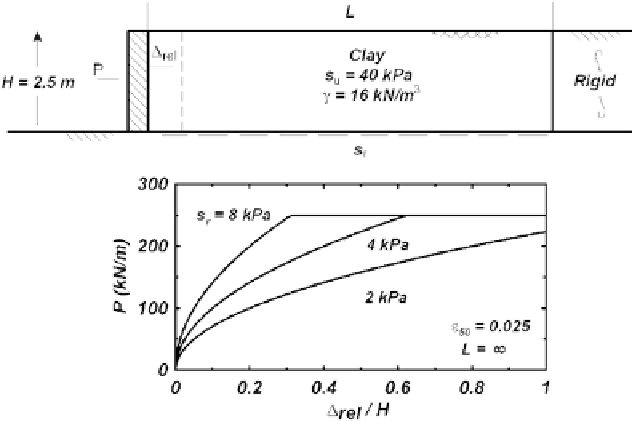Geoscience Reference
In-Depth Information
Fig. 12.7. Effect of liquefaction on the load transfer inan overlying layer of
elastic-plasticclay: (a) two-dimensional geometry, (b)load transfer if the clay layer is
infinitely long and theunderlying liquefied sandhas various residual strengths
Lateral load transfer between the nonliquefied crust and individual piles may also be
affected by liquefaction in the underlying sands. A closely-spaced group of piles has the
potential to effectively act as a wall for the nonliquefied crust if the total lateral load
capacityagainstthepilesisgreaterthanthetotallateralloadcapacitythatwoulddevelop
if the piles act as a wall. If they act as a wall, then the lateral load transfer would be soft-
enedinthesamewayasdescribedforthepilecap.Ifthepilesactindividually, theeffect
of liquefaction on their combined load transfer behavior is less certain and more likely
depends on the specific problem geometry. In either case, the presence of the liquefied
layer will reduce the ultimate lateral loads that can develop against the pile in the over-
lying or underlying nonliquefied layers to a distance of a few pile diameters from their
contact with the liquefied layer (as illustrated by 3D finite element analyses for layered
soils by Yang and Jeremic, 2002).
The ultimate p-y capacities for single piles subject to large numbers of loading cycles at
thepileheadareoftenreducedfromtheirstaticcapacitiesbycyclicloadingfactors(e.g.,
Matlock 1970, API 1993). For seismic loading, piles may experience only a few strong
cyclesofinertialoadingfromthesuperstructure,andthelateralloadingfromaspreading
crustwillhaveamonotonicbiasinthedirectionofspreading.Resultsofcentrifugemodel
tests and analyses of single piles in a profile similar to that in Figure 12.2 showed that
theloadingimposedbyalaterallyspreadingclaycrustwascomparabletothemonotonic
lateralloadingcapacityofthep-ysprings,andthattheuseofcyclicloadingfactorswould
have been unconservative (Boulanger et al., 2003).
















